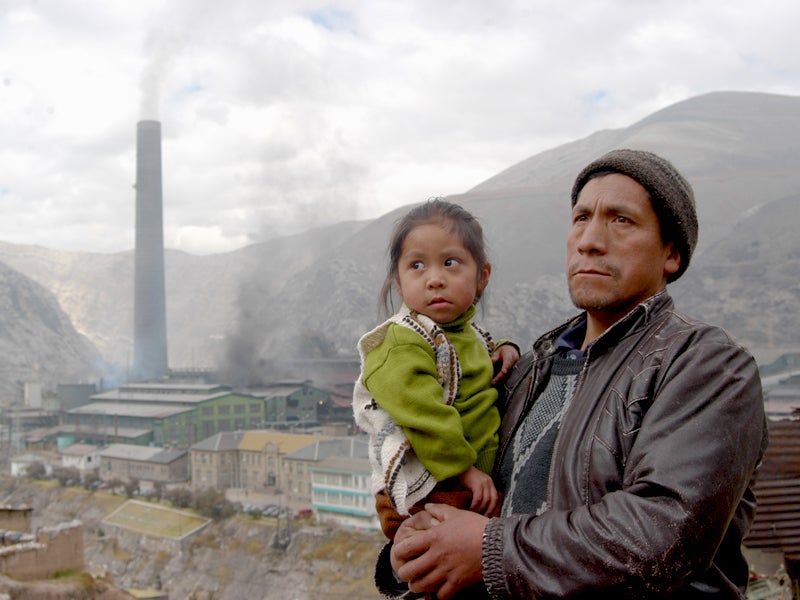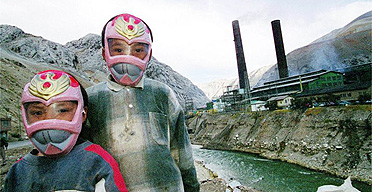Latin America
Related: About this forumReclusive billionaire who owns $425M Hamptons estate may have to face trial in lead-poisoning case
By Josh Kosman
Published Dec. 9, 2024, 6:00 a.m. ET
eclusive billionaire Ira Rennert, owner of the largest estate in the Hamptons, could soon face the spotlight over alleged lead poisoning at a Peruvian mine – a lawsuit he has tried to get tossed for nearly two decades.
The 90-year-old founder of industrial conglomerate Renco is best known in New York circles for the massive, oceanfront property on the East End he purchased in the 1990s.
The compound at 281 Daniels Lane in Sagaponack – dubbed the “House that Ate the Hamptons” in the title of a book by legendary Page Six founder James Brady – has grown to include a 110,000-square-foot main house with 29 bedrooms and 39 bathrooms, as well as a 100-car garage.

Ira Rennert smiling wearing a winter jacket.
Ira Rennert is likely headed to trial in the first half of 2025.
Steven Hirsch
In 2010, the New York-born industrialist allegedly ran afoul of Southampton zoning officials after trying to add a 40th bathroom outdoors, according to Curbed Hamptons.
Rennert’s estate — most recently assessed at $425 million — features three swimming pools, two tennis courts, a 164-seat theater, a basketball court, a bowling alley and even a synagogue on its 63 acres, which abuts the Atlantic Ocean.
More:
https://nypost.com/2024/12/09/business/ira-rennert-who-owns-425m-hamptons-estate-ordered-to-stand-trial-in-lead-poisoning-case/
~ ~ ~
Old article, focusing on dirtbag Rennert's "house":
July 9, 2012
The House That Ate the Hamptons

Ira Rennert's Fair FieldWikimedia Commons
Fight disinformation: Sign up for the free Mother Jones Daily newsletter and follow the news that matters.
This weekend, Mitt Romney made a very profitable swing through the Hamptons. On the agenda: A trio of fundraisers, including a $50,000-a-head party at David Koch’s $18 million estate and a shindig at financier Ronald Perelman’s 57-acre estate, home to “the most outstanding private conifer collection in the United States.” But those spreads have nothing on billionaire Ira Rennert’s estate in Sagaponack (which, sadly for Romney, did not host a fundraiser).
Thought to be America’s largest inhabited residence, Fair Field cost $100 million to build and is worth at least $200 million. The 110,000-square-foot complex has 29 bedrooms, 39 bathrooms, three pools, two libraries, a bowling alley, a playground, a full theater, its own power plant, and a garage for 100 cars. The main building is 66,000 square feet, 28 times bigger than the average new house. It’s the third-largest private home in America. (No. 1 is the 174,000- square-foot Biltmore Estate.) The mansion even inspired a novel, The House That Ate the Hamptons. Kurt Vonnegut called it “the greatest book ever written.” In a rare public appearance, Rennert described his mega-mansion as “old age and loneliness insurance.”
A local architect who approved the project praised its “restrained classic design.” Or, as one local put it to MoJo‘s Josh Harkinson, “It’s a fucking monster!” Fair Field is now at the heart of a new controversy between Rennert and his slightly less affluent neighbors, who have accused him of “practicing class warfare” with his noisy private helicopters. Seriously. Check it out.
https://www.motherjones.com/politics/2012/07/house-ate-hamptons-ira-rennert/

Judi Lynn
(163,195 posts)in La Oroya, Peru. He is known throughout the world for his unbelievable trashy, destructive businesses. The damage done to the people of Peru is ferocious. If people around there try to have pets for their kids, the pets die very quickly.
It IS that bad.
First article from the post:
Report on the situation in La Oroya : When investor protection threatens human rights
Last Update 7 May 2013
FIDH released a report on the situation in La Oroya, a city in the central Andean region of Peru that is at the center of a controversial case of industrial pollution caused by a poly-metallic smelter in operation since 1922.
For decades, the people of La Oroya have been exposed to high levels of air pollution stemming from the complex’s emissions of toxic substances including lead, cadmium, arsenic and sulfur dioxide. In the middle of the 2000s La Oroya was identified as one of the 10 most polluted cities in the world.
According to independent studies, 97% of children between the ages of 6 months and 6 years, and 98% of those between 7 and 12 years old still have high levels of lead in their blood. The percentage reaches 100% in La Oroya Antigua, the area closest to the smelter. The effects of lead poisoning are irreversible.
Doe Run Peru, a subsidiary of the U.S.-based Doe Run Company, began operating the complex after its privatization in 1997. Both the company and the Peruvian State have failed to comply with their obligations to prevent environmental impact and respect the human rights of the population of La Oroya. In response, the Interamerican Association for Environmental Defense (AIDA) and other organizations requested the Inter-American Commission on Human Rights (IACHR) in 2005 to issue precautionary measures for people whose health was at serious risk from the pollution in the city. On August 31, 2007 the IACHR ordered the State to adopt measures to protect the health, integrity and life of a group of residents of La Oroya.
More:
http://www.fidh.org/report-on-the-situation-in-la-oroya-when-investor-protection-threatens-13241
More information follows:
https://www.democraticunderground.com/110816163
You have to wonder if he ever has any sleepless nights, knowing how hideous his way of making a living has been, destroying the lives of so very, very many people, robbing them of their very well-being. Poor people can't just get up and start somewhere else or move to one of their other mansions. They don't have the means to escape from Rennert's hell on earth.
Judi Lynn
(163,195 posts)Sat Mar 23, 2024, 06:22 PM

María Paz Rodríguez Galiano | Facultad de Derecho PUCP, PE
MARCH 23, 2024 09:48:51 AM
The Inter-American Court of Human Rights (IACHR) conducted the notification of the judgment in the case of Residents of La Oroya v. Peru this Friday, addressing the Peruvian State’s responsibility for the damage suffered by 80 residents of La Oroya and ordered the payment of compensation to the victims for the damage incurred.
In December 2002, a group of residents of La Oroya, located in the Peruvian highlands, filed a compliance lawsuit against the Ministry of Health and the General Directorate of Environmental Health of Peru, seeking protection of their right to health and a healthy environment. The community argued that the company managing the La Oroya Metallurgical Complex (CMLO) failed to comply with environmental protection standards, leading to extremely high levels of lead and other components in the blood of children and pregnant mothers in the community.
In 2006, the Peruvian Constitutional Court ordered the adoption of measures to protect the community. However, in 2020, the IACHR indicated that, more than 14 years after the court’s decision, there was no evidence that the state had taken effective measures to fully implement the Peruvian judgment.
In its judgment, the court declared the Peruvian State’s international responsibility for violating the right to a healthy environment for the residents of La Oroya. The court noted that Peru, despite being aware that CMLO generated high levels of pollution, did not fulfill its obligations to protect the rights of the population.
More:
https://www.jurist.org/news/2024/03/iachr-orders-peru-to-compensate-victims-of-lead-poisoning-living-near-mine/#







(Before they were apprehended so very late in the game, the company used to wait until dark, then started pumping deadly chemical-laden water into the small river. )
More information, photos, video on the pollution:
https://democraticunderground.com/110889291